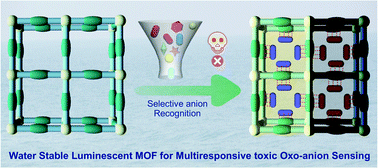A luminescent cationic MOF for bimodal recognition of chromium and arsenic based oxo-anions in water†
Abstract
Water pollution from heavy metals and their toxic oxo-anionic derivatives such as CrO42−, Cr2O72−, HAsO42−, and HAsO32− has become one of the most critical environmental issues. To address this, herein, we report a new hydrolytically stable luminescent Zn(II) based cationic metal organic framework (MOF), iMOF-4C, which further successfully exhibited a rare dual “turn off/on” fluorescence response toward Cr(VI), As(V) and As(III) based oxo-anions respectively in water medium. In addition, iMOF-4C was found to maintain its superior selectivity in the presence of other concurrent anions (e.g. SO42−, Cl−, Br−, ClO4−, NO3−, SCN− and CO32−). More importantly, iMOF-4C exhibited an excellent selective and sensitive luminescence “turn-off” response towards CrO42− and Cr2O72− anions in water medium with the quenching constant (Ksv) values as high as 1.31 × 105 M−1 (CrO42−) and 4.85 × 105 M−1 (Cr2O72−), which are found to be the highest among the values reported in the regime of MOFs. Interestingly, iMOF-4C showed fluorescence “turn-on” response toward HAsO42− and HAsO32− with an enhancement coefficient (Kec) of 1.98 × 104 M−1 and 3.56 × 103 M−1 respectively. The high sensitivity and low detection limits make iMOF-4C more feasible for real-time sensing of such toxic oxo-anions in an aqueous medium. Furthermore, the probable sensing mechanism has been investigated by DFT calculation studies and discussed in detail.

- This article is part of the themed collection: Spotlight Collection: MOF Sensors


 Please wait while we load your content...
Please wait while we load your content...